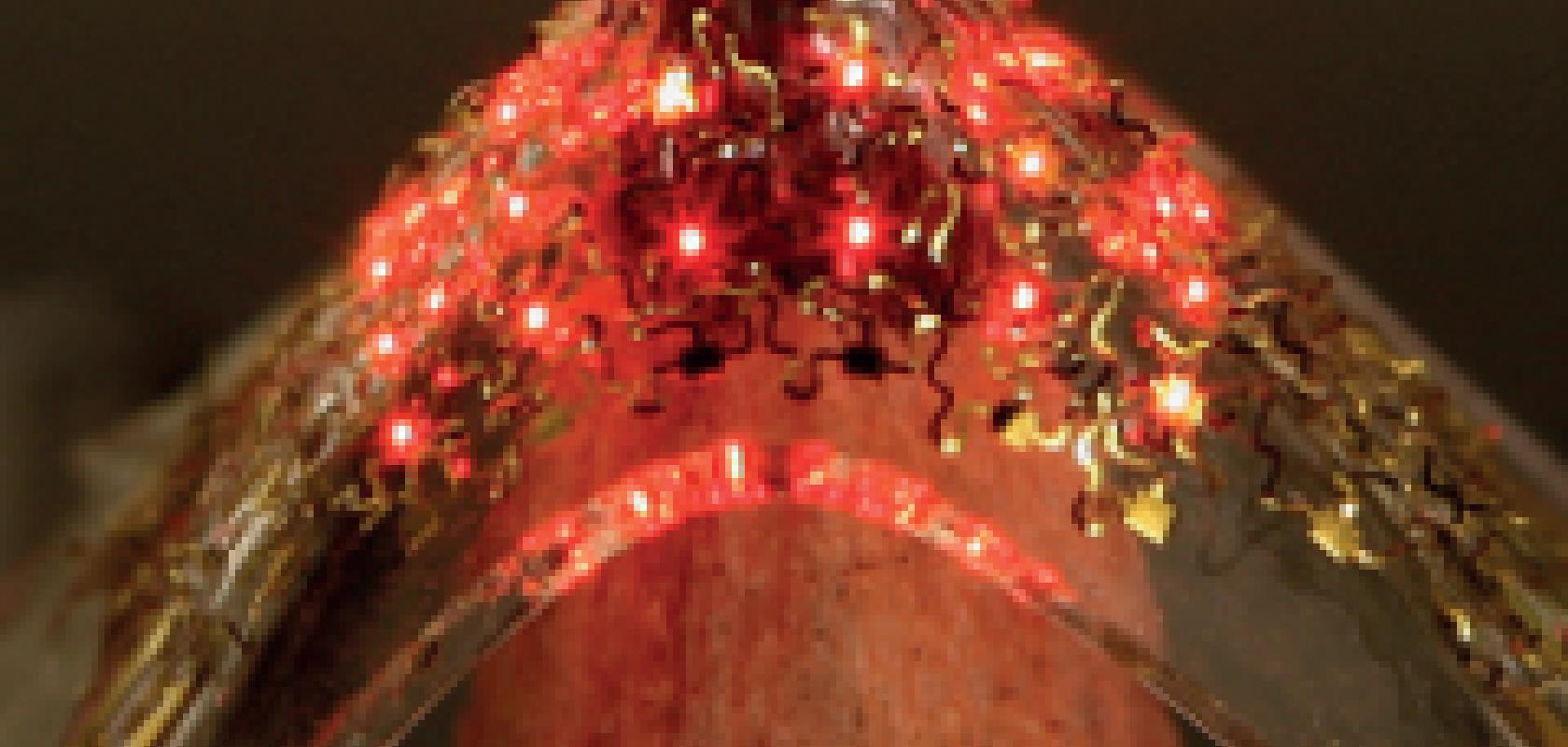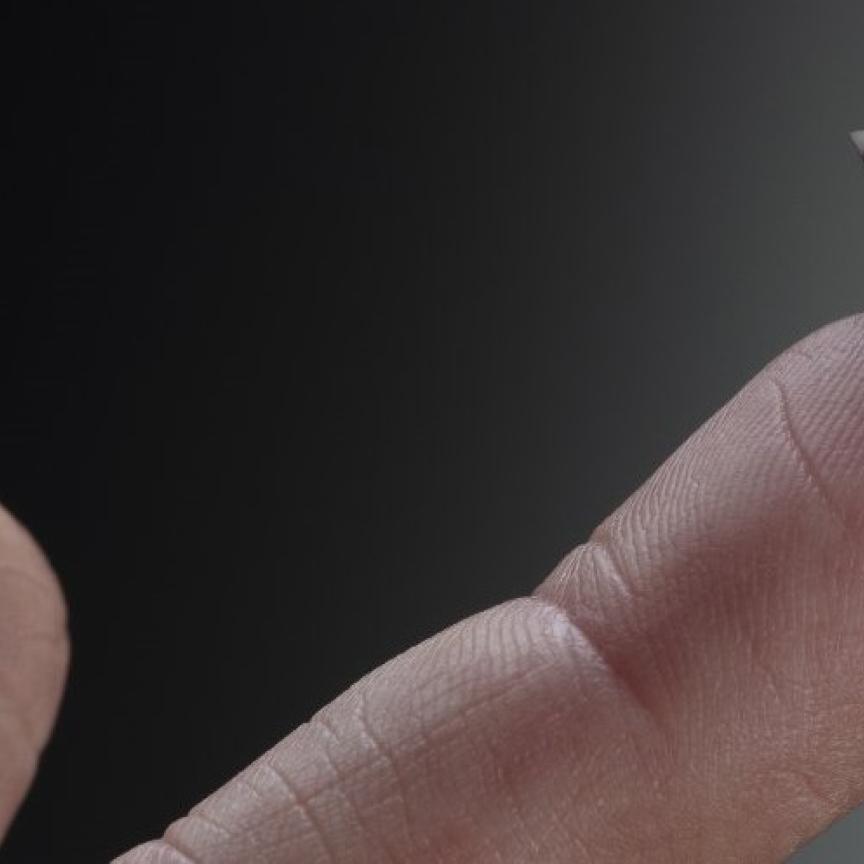There was a time when displays had to be rigid. Now, with the advent of light-emitting polymers and electronic paper technology, flexible displays are coming onto the market and enabling new applications like flexible signage and eReaders. But what if we went one step further? What if displays were not only flexible, but also stretchable? Is stretchability in a display necessary? Surely flexibility is enough for most applications?
Not necessarily. For some applications, stretchability is important. Take, for example, the idea of a mobile device, such as a phone, with a fold-up display. While flexibility is key, at some parts of the display such as the parts where it is folded, the display would also have to stretch. Mobile phone manufacturer Nokia has already come up with, and patented, a concept – the Nokia Morph. Developed at the Nokia Research Centre and Cambridge Nanoscience Centre, both in Cambridge, UK, the Morph is a mobile device whose ‘elasticity enables the device to literally change shapes and configure itself to adapt to the task at hand’ according to Nokia.
Other markets where stretchable displays would enable new applications are the medical sector, fashion industry, robotics and large-area displays. However, the idea of stretchable displays is so new, and the market so challenging, that not many people are developing the technology. Research efforts are concentrated at four main groups: Prof John Rogers’ group at the University of Illinois at Urbana-Champaign, US[1]; Prof Takao Someya’s group at the University of Tokyo, Japan[2]; Prof Qibing Pei’s group at the University of California Los Angeles, US[3] and Prof Tricia Breen Carmichael’s group at the University of Windsor in Canada[4].
Each group has demonstrated stretchable displays, but each uses a different approach.
Prof Rogers’ group uses arrays of discrete inorganic micro-LEDs that are connected by a flexible, stretchable substrate. ‘We decided to use inorganic LEDs because this is an established industry and the devices have excellent lifetimes, efficiency and brightness,’ Rogers tells Electo Optics magazine. ‘We had to develop a technique for manufacturing the micro-LEDs and integrating them into the stretchable substrate.’
The micro-LEDs that Rogers and his colleagues use are typically 100µm x 100µm with a total thickness of just a few microns – this makes them several orders of magnitude smaller than commercially available devices. They need to be this thin in order to enable the use of thin-film metallisation technology for interconnects and optimised mechanical design. ‘We used a dual-transfer process that involves first printing the semiconductor materials onto a temporary substrate to form contacts, interconnections and structural bridges, and encapsulation layers,’ explains Rogers. ‘We then dissolve the temporary substrate and use a second transfer-printing step to integrate the devices onto elastomeric sheets.’
This means that the interconnects between the micro-LEDs stretch, but the LEDs themselves are rigid. Using this approach, Rogers and his colleagues have made arrays of LEDs with various sizes and layouts, including up to 16 x 16, and Rogers believes the concept is scalable up to a few hundred pixels at least. He points out that electronics giant Sony recently showed a 55-inch LED TV based on this concept of discrete micro-LEDs. ‘Sony’s Crystal LED TV contains six million discrete micro-LEDs and is different to other LED TVs in that it has no backlight,’ explains Rogers. ‘The micro-LEDs are the pixels and are self-illuminating. This shows that micro-LEDs can be manufactured and connected in large numbers.’
The efficiency and brightness of the micro-LEDs in Rogers’ design play an important role in enabling stretchability. While the LEDs themselves are not stretchable, when the display is stretched, the gaps between the LEDs will increase. But, because the LEDs are so bright, the human eye will not be able to notice the increase in these gaps. ‘The LEDs illuminate a large pixel area, which is larger than their actual size,’ explains Rogers. ‘If the light-scattering component is stretchable, then no gaps are perceived in the display.’
But there are, of course, many challenges to be overcome before a commercial stretchable display becomes available. As ever, thermal management is a challenge, but as Prof Rogers points out: ‘The micro-LEDs have a large surface area relative to their size, so the rate of passive heat spreading increases.’
In Japan Prof Takao Someya’s group at the University of Tokyo has taken a similar approach to Rogers, but has used discrete organic LEDs (OLEDs) instead of discrete inorganic micro-LEDs. For the electronic circuit, Someya and his colleagues used single-walled carbon nanotubes (SWNTs) uniformly dispersed in a fluorinated rubber. These showed a high conductivity and a stretchability of more than 100 per cent. The researchers made a rubber-like stretchable active-matrix display comprising integrated printed elastic conductors, organic transistors and organic light-emitting diodes. The display could be stretched by 30 to 50 per cent and spread over a hemisphere without any mechanical or electrical damage. It also remained functional even when folded in two or crumpled up, indicating excellent durability.
An encapsulation layer made of plastic barrier films acted as an excellent gas barrier so that the organic LEDs were not degraded even when operating in ambient air; the lifetime in air is at least three months.
The group believes miniaturisation is possible and has successfully patterned printable elastic conductors with linewidths of 100µm using screen printing. Screen printing has been used to pattern down to even smaller resolutions, and OLEDs can be printed too.
Professor Qibing Pei’s group at the University of California Los Angeles has gone one step further. Prof Pei and his colleagues have also used single-walled carbon nanotube (SWNT)-polymer composite electrodes but have chosen not to use discrete LEDs. Instead they have used a polymer LED material to create a highly stretchable semiconductor device, wherein every part is intrinsically stretchable.
‘We were working on the electrical actuation of polymers to mimic muscle function and needed to develop a stretchable, conductive electrode,’ explains Pei. ‘We also had another project on polymer LEDs running in my lab and we decided to combine the two to make a stretchable display.’
What started as a scientific curiosity has now become a project with interesting applications. ‘People want large screens on their iPhones,’ says Pei. ‘But large screens are no good if you want to put your iPhone in your pocket. If the phones of the future are going to have roll-up or foldable displays, then they must also be stretchable.’
Pei believes his approach has some advantages over Rogers’ and Someya’s designs in the long run. ‘With a discrete approach, you need to mount large numbers of discrete LEDs and this will limit the resolution and keep costs high,’ says Pei. However, the technology that Rogers uses is mature whereas Pei’s relies on new materials whose properties are not yet fully understood.
For example, it is perhaps a little surprising that the conductivity of the SWNT networks increases when the device is stretched. Stretching up to 35 per cent increased the conductivity by up to 50 per cent compared with the values before stretching. This could be due to the alignment of the nanotubes in the material to create a more oriented microstructure which facilitates charge transportation.
To create the light-emitting part of the device, Pei and his colleagues made a polymer light-emitting electrochemical cells using a roll lamination process. A luminescent polymer layer consisting of a blue emissive polyfluorene copolymer, an ionic conductor and a salt was laminated between two SWNT-polymer electrodes.
The proof-of-concept device is small – two-centimetre square with a one-centimetre square area that emits a sky-blue light – but Pei believes the relatively simple manufacturing process is scalable to larger dimensions. Pei and his colleagues are now looking at the reversibility of the stretching process and are also looking for a suitable encapsulation material. ‘This is going to be a challenge,’ admits Pei. ‘We will have to be creative. It is not impossible.’
Prof Tricia Breen Carmichael’s group at the University of Windsor in Canada has also made an intrinsically stretchable light-emitting device but believes her approach has one major advantage over Pei’s approach. She tells Electro Optics magazine: ‘I think Pei’s work is really impressive. The stretching that these devices can tolerate and still function is quite remarkable. The difference between this work and ours is that Pei uses a polyacrylate substrate that is not stretchable at room temperature. Our device is made from an elastomeric material (PDMS), which we use as both the substrate and as a matrix for the electroluminescent ionic transition metal complex. Our device is stretchable at room temperature.’
Carmichael and her colleagues have essentially developed a stretchable light-emitting electrochemical cell (LEECs) instead of an OLED. LEECs are a class of electroluminescent device that use a mixture of ionic and electronic conductors sandwiched between two metal electrodes to support all three processes of charge injection, charge transport, and emissive recombination. To make the stretchable light-emitting device, LEEC technology was combined with earlier work by Carmichael’s group on a low-cost method for making stretchable copper wires by depositing patterned copper films using electroless plating on PDMS.
Carmichael believes this approach is scalable for making large-area stretchable displays. ‘Our focus now is to take these devices beyond the proof-of-concept stage. We are working on implementing new stretchable electrical contacts and new device configurations,’ said Carmichael. ‘Right now, the biggest hurdle is the electrical contacts. We used the simplest materials available to be able to demonstrate the proof-of-concept of a stretchable electroluminescent material. The cathode is liquid metal, which can deform along with the rest of the device but isn’t a practical choice for scale-up. We need to find and integrate electrodes that alleviate these problems. This will allow us to make a prototype device that is larger than the proof-of-concept, and hopefully will tell us how stretchable we can really make these devices.’
This is just one of the many challenges that need to be overcome before stretchable displays come to market. And even when/if they do make it to market, whether or not they succeed is another matter.
Rogers’ work is being commercialised by US company MC10. Kevin Dowling, VP of research and development at MC10 is excited about the possibilities but warns of challenges ahead. ‘There are several companies pioneering efficient small LEDs and stretchable electronics technology has made great strides in recent years,’ he said. ‘But the displays market is an extraordinarily competitive and aggressive market and in order to survive a company will have to have the right technology for the right application. In markets such as this, the fact that a display is flexible, or even stretchable, may not be enough. It needs to also have the right price and performance characteristics in order to succeed.’
Nokia Morph: http://research.nokia.com/morph
MC10: http://mc10inc.com/
References:
1. Kim R-H, et al., Nature Materials, Vol 9, p929
2. Sekitani, T et al, Nature Materials, Vol 8, p494
3. Yu, Z et al, Advanced Materials, Vol 23, p3989
4. Filiatrault, H et al, Advanced Materials, Vol 24, p2673


